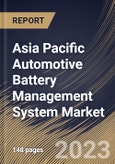Battery safety is paramount in the automotive industry, and BMS plays a crucial role in monitoring and maintaining the security and reliability of battery packs. Ensuring the health of the battery helps build trust among consumers and regulators. Effective battery management systems contribute to extending the range of electric vehicles and enhancing their overall performance. This is essential to compete with traditional internal combustion engine (ICE) vehicles and to meet the expectations of consumers regarding driving experience. As economies of scale are realized in producing electric vehicles and their components, including battery management systems, the costs associated with these technologies are expected to decrease. Lower prices make EVs more affordable and increase their attractiveness to consumers.
PHEVs have a battery and gasoline engine, allowing drivers to switch between electric and hybrid modes. Battery management systems (BMS) in PHEVs help manage the battery's state of charge and maintain battery health, allowing drivers to use electric power for shorter trips while relying on the gasoline engine for longer journeys. Automotive Battery Management Systems are not limited to passenger vehicles. They are also crucial in electric buses, trucks, and other forms of public transportation. These systems enable longer operating ranges and help reduce the environmental impact of mass transit. BMS technology is not restricted to vehicles; it is also used in stationary energy storage systems. These systems store surplus energy from renewable sources, such as solar panels and wind turbines. Battery management systems are essential for maintaining the health and performance of these energy storage units.
The Asia Pacific region, particularly nations like China and Japan, are experiencing a significant surge in the production and adoption of electric vehicles. Several countries in the Asia Pacific region have implemented strict emission standards. BMS technology is essential for automakers to produce compliant and eco-friendly vehicles. High population density and urbanization in many Asian cities have led to concerns about air quality and congestion. The above aspects will expand the market growth across the region in the upcoming years.
The China market dominated the Asia Pacific Automotive Battery Management System Market by Country in 2022, and would continue to be a dominant market till 2030; thereby, achieving a market value of $1,991 million by 2030. The Japan market is registering a CAGR of 19.4% during (2023 - 2030). Additionally, The India market would experience a CAGR of 21% during (2023 - 2030).
Based on Component, the market is segmented into Hardware, and Software. Based on Battery Type, the market is segmented into Lithium-ion, Lead-acid, and Others. Based on Application, the market is segmented into Passenger Vehicles, Commercial Vehicles, and Others. Based on Topology, the market is segmented into Modular, Centralized, and Distributed. Based on countries, the market is segmented into China, Japan, India, South Korea, Singapore, Malaysia, and Rest of Asia Pacific.
The market research report covers the analysis of key stakeholders of the market. Key companies profiled in the report include Eberspächer Gruppe GmbH & Co. KG, Sensata Technologies Holding PLC, AVL List Gmbh, LG Energy Solution Ltd., Ficosa International S.A, Leclanché S.A, Nuvation Energy, Futavis Gmbh (Deutz AG), Toshiba Corporation, Elithion, Inc.
Scope of the Study
Market Segments Covered in the Report:
By Component- Hardware
- Software
- Lithium-ion
- Lead-acid
- Others
- Passenger Vehicles
- Commercial Vehicles
- Others
- Modular
- Centralized
- Distributed
- China
- Japan
- India
- South Korea
- Singapore
- Malaysia
- Rest of Asia Pacific
Key Market Players
List of Companies Profiled in the Report:
- Eberspächer Gruppe GmbH & Co. KG
- Sensata Technologies Holding PLC
- AVL List Gmbh
- LG Energy Solution Ltd.
- Ficosa International S.A
- Leclanché S.A
- Nuvation Energy
- Futavis Gmbh
- Toshiba Corporation
- Elithion, Inc.
Unique Offerings
- Exhaustive coverage
- The highest number of Market tables and figures
- Subscription-based model available
- Guaranteed best price
- Assured post sales research support with 10% customization free
Table of Contents
Companies Mentioned
- Eberspächer Gruppe GmbH & Co. KG
- Sensata Technologies Holding PLC
- AVL List Gmbh
- LG Energy Solution Ltd.
- Ficosa International S.A
- Leclanché S.A
- Nuvation Energy (Nuvation Research Corporation)
- Futavis Gmbh (Deutz AG)
- Toshiba Corporation
- Elithion, Inc.
Methodology

LOADING...








